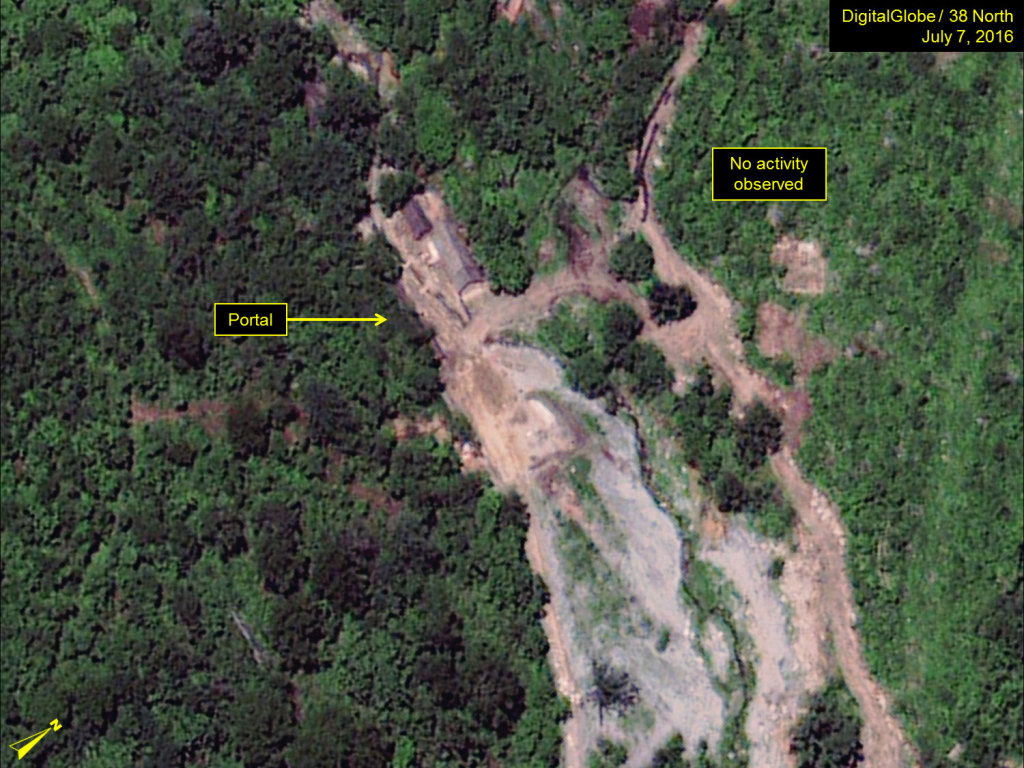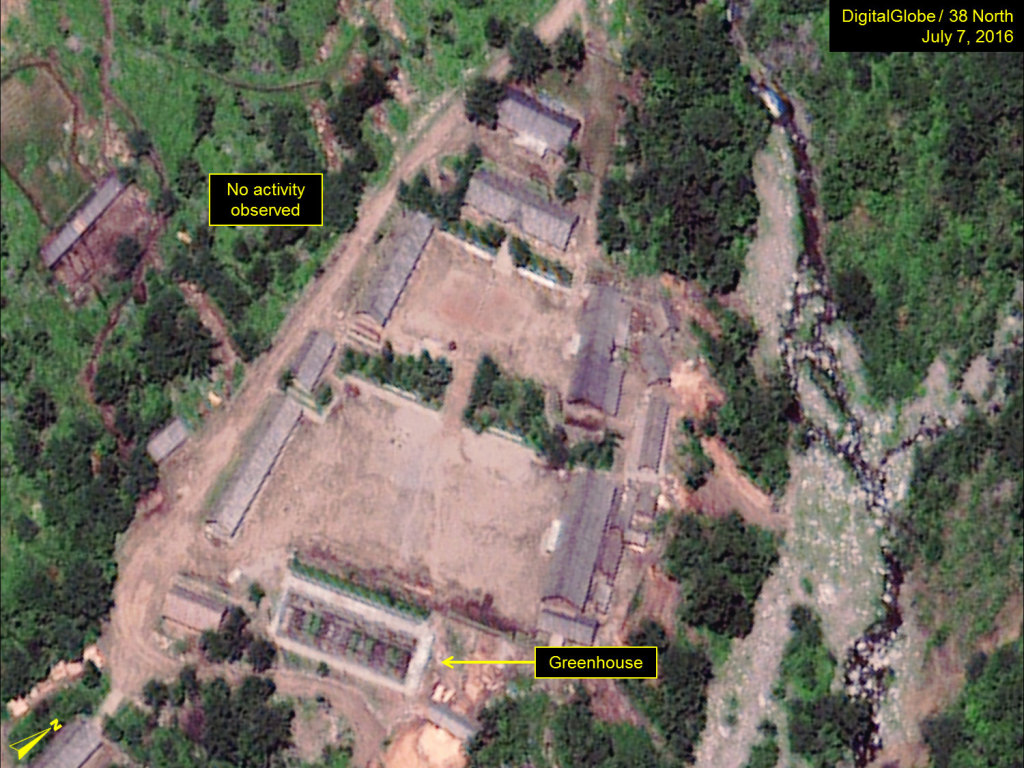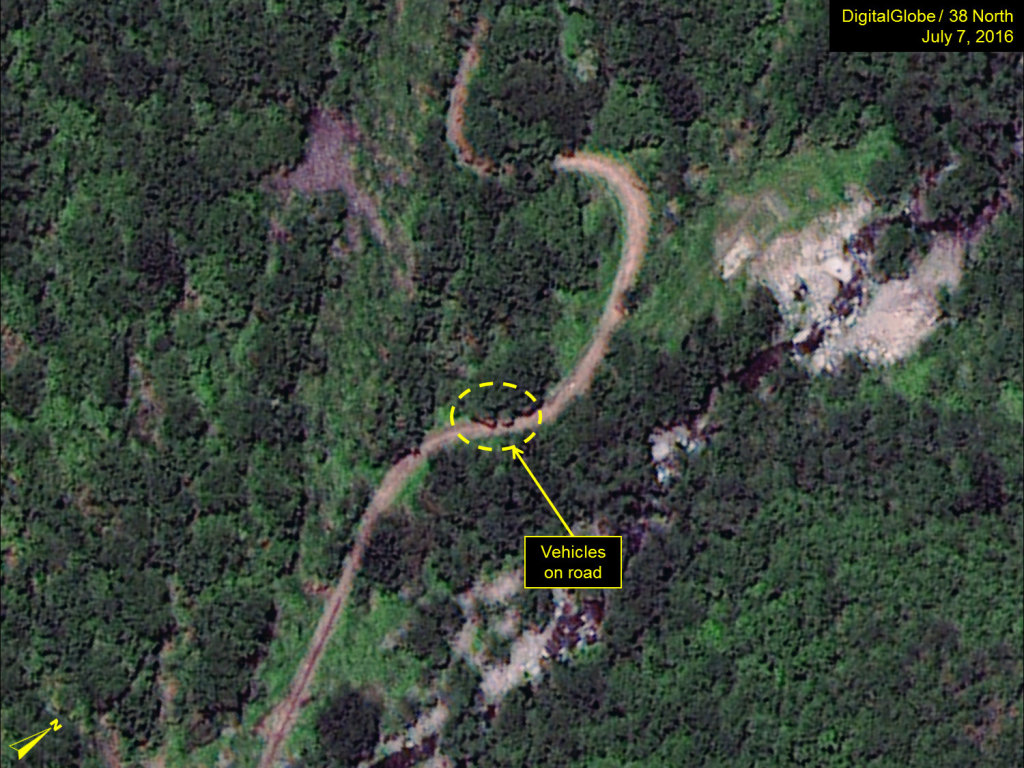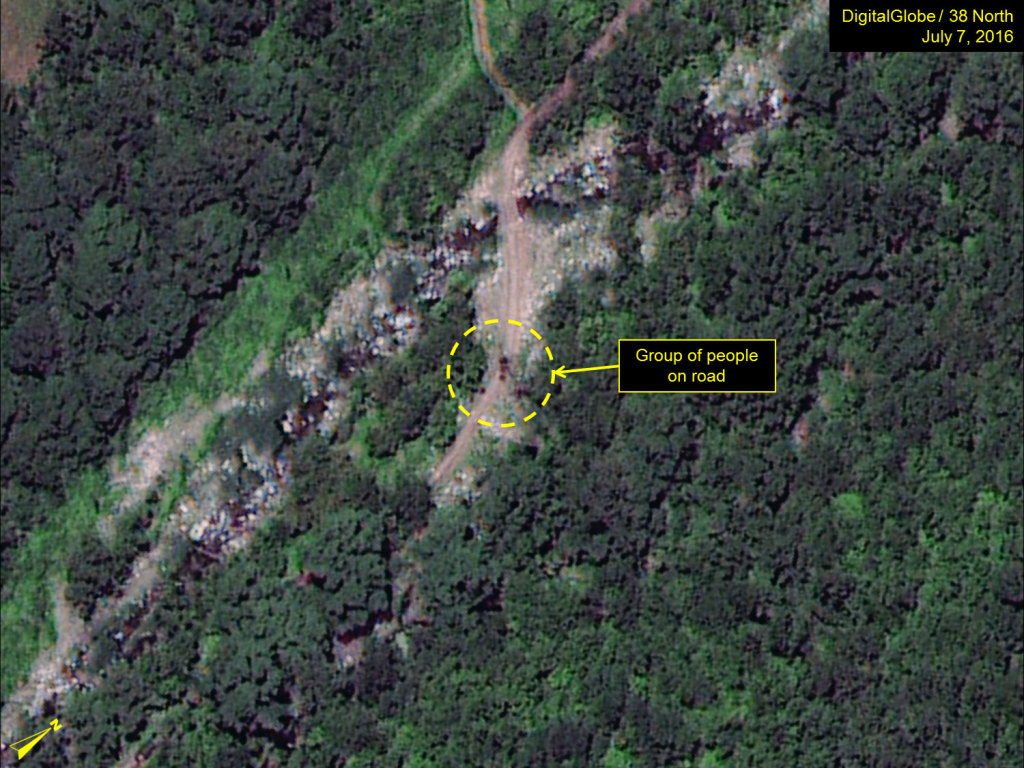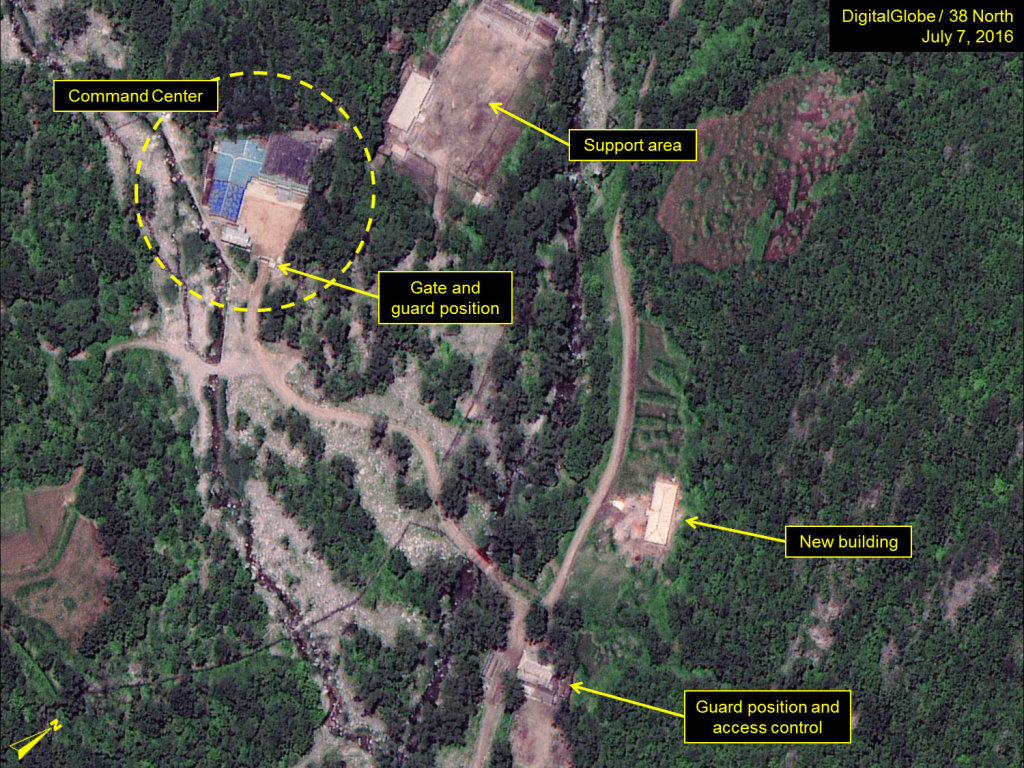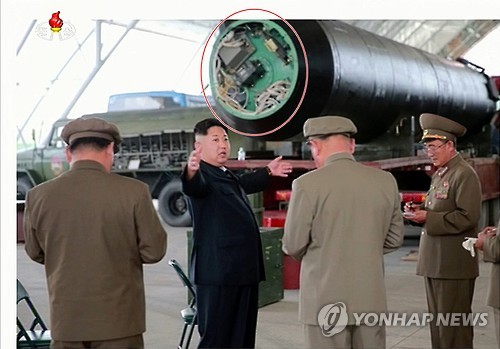Tuesday, July 19, 2016
North Korea: High Level of Activity at Nuclear Test Site Portal but Purpose is Unclear!
Summary
Recent commercial satellite imagery indicates a high level of activity at North Korea’s Punggye-ri Nuclear Test Site, specifically at the North Portal area where the DPRK conducted its 2013 and 2016 nuclear tests. Based on imagery alone, it is not possible to determine whether this activity is for maintenance, excavation or preparation for a fifth nuclear test. Nevertheless, it is clear that North Korea is ensuring that the facility is in a state of readiness that would allow the conduct of future nuclear tests should the order come from Pyongyang.
High Level of Activity at North Portal
Commercial satellite imagery from July 7 indicates a high level of activity at the North Portal. What appears to be supplies and/or equipment are stacked on the ground south and southeast of the portal. Additionally, a small vehicle is present at the support building immediately to the south of the portal. Several mine ore carts may also be present southeast of the portal, suggesting the tunnel is being actively worked. However, the resolution of the image is insufficient to provide further insight into the nature of this activity.
Figure 1. Supplies/equipment, vehicle and several mine ore carts identified at the North Portal.
Limited Activity at West Portal
Imagery shows little activity at the West Portal although what appear to be two mine ore carts are present on the tailings pile to the east. Their presence suggests that work is taking place at the tunnel. The winter melt and runoff, combined with recent rains, produced a small landside just uphill of the portal. It is unclear if this has affected operations at the site.
Figure 2. Two mine ore carts present at the West Portal.
No Activity at South Portal or Main Support Area
There is no activity identified at the South Portal, though runoff (caused by winter melt and recent rain) is visible in the area. This is also true at the Main Support Area, although greenhouse activity and light ground scarring indicate the area is active.
Figure 3. No activity at South Portal.
Figure 4. No activity at the Main Support Area.
Activity on Facility Access Road
Several groups of people and small vehicles are visible on the road south of the test facility. The nature or purpose of their presence is unclear, although it is likely that they are either engaged in spring maintenance or travelling to and from the test facility.
Figure 5. Vehicles identified on facility access road.
Figure 6. Group of people visible on road.
Little Activity in the Command Center Area
Imagery shows no vehicles or activity in the secured Command Center area. Camouflage is visible on the southernmost building, but it is unclear why this building has a camouflaged roof since the light blue/dark blue pattern stands out dramatically against the green forests around it.
Imagery indicates the construction of a building east of the Command Center and on the main road to the test facility. The purpose of this new building is unclear, but its position—east of the Command Center and between the north and south guard positions—suggests that it may support the security forces in this area.
Figure 7. New building constructed at the Command Center area.
North Korea: High Level of Activity at Nuclear Test Site Portal but Purpose is Unclear!
Summary
Recent commercial satellite imagery indicates a high level of activity at North Korea’s Punggye-ri Nuclear Test Site, specifically at the North Portal area where the DPRK conducted its 2013 and 2016 nuclear tests. Based on imagery alone, it is not possible to determine whether this activity is for maintenance, excavation or preparation for a fifth nuclear test. Nevertheless, it is clear that North Korea is ensuring that the facility is in a state of readiness that would allow the conduct of future nuclear tests should the order come from Pyongyang.
High Level of Activity at North Portal
Commercial satellite imagery from July 7 indicates a high level of activity at the North Portal. What appears to be supplies and/or equipment are stacked on the ground south and southeast of the portal. Additionally, a small vehicle is present at the support building immediately to the south of the portal. Several mine ore carts may also be present southeast of the portal, suggesting the tunnel is being actively worked. However, the resolution of the image is insufficient to provide further insight into the nature of this activity.
Figure 1. Supplies/equipment, vehicle and several mine ore carts identified at the North Portal.
Limited Activity at West Portal
Imagery shows little activity at the West Portal although what appear to be two mine ore carts are present on the tailings pile to the east. Their presence suggests that work is taking place at the tunnel. The winter melt and runoff, combined with recent rains, produced a small landside just uphill of the portal. It is unclear if this has affected operations at the site.
Figure 2. Two mine ore carts present at the West Portal.
No Activity at South Portal or Main Support Area
There is no activity identified at the South Portal, though runoff (caused by winter melt and recent rain) is visible in the area. This is also true at the Main Support Area, although greenhouse activity and light ground scarring indicate the area is active.
Figure 3. No activity at South Portal.
Figure 4. No activity at the Main Support Area.
Activity on Facility Access Road
Several groups of people and small vehicles are visible on the road south of the test facility. The nature or purpose of their presence is unclear, although it is likely that they are either engaged in spring maintenance or travelling to and from the test facility.
Figure 5. Vehicles identified on facility access road.
Figure 6. Group of people visible on road.
Little Activity in the Command Center Area
Imagery shows no vehicles or activity in the secured Command Center area. Camouflage is visible on the southernmost building, but it is unclear why this building has a camouflaged roof since the light blue/dark blue pattern stands out dramatically against the green forests around it.
Imagery indicates the construction of a building east of the Command Center and on the main road to the test facility. The purpose of this new building is unclear, but its position—east of the Command Center and between the north and south guard positions—suggests that it may support the security forces in this area.
Figure 7. New building constructed at the Command Center area.
Thursday, June 30, 2016
LATEST INTEL ON NORTH KOREA - Musudan missile!
North Korea has just released an image of Kim Jong Un posing in front of a Musudan missile (Hwasong-10) with the reentry vehicle removed. In addition to showing the grid fins in their stowed configuration, this view shows us the missile’s guidance package. The resolution is not high enough to positively identify specific components or assemblies, but it clearly isn’t the guidance system from a 1960s-vintage Russian R-27 missile. In the original Russian design, the rather bulkier guidance system was fit into a depressed cavity at the top of the propellant tank; the North Koreans have instead fit the electronics into the narrow space atop a normal tank dome. This means they have rebuilt the tank dome as well as the guidance system, though this comes as no surprise given that the missile’s propellant tanks have been stretched by almost 2.5 meters to increase its range.
Even if North Korea obtained complete R-27 missiles from Russia in the 1990s, it is unlikely they would trust 40-year-old electronics to control it. And we know that North Korea has the ability to build their own guidance systems, whether for shorter-ranged Nodong missiles or for Unha satellite launch vehicles. We know from recovered Unha wreckage that they are willing to use modern imported commercial-grade electronics in their missiles, which would explain why their guidance system is smaller than the Russian original.
What we don’t know is how well it performs. Precision components like missile-grade mechanical or laser gyroscopes are difficult to build and difficult to import without it being obvious that one is importing missile parts. Possibly the North Koreans have found a supplier that doesn’t care, or possibly their own technicians have mastered the art of building these systems. At a minimum, the Musudan is capable of completing a flight without tumbling out of control, at least some of the time, and even if it is no more precise than North Korea’s other missiles, it is still almost certainly accurate enough to hit, for example, the island of Guam. Although, hitting specific targets on Guam, like the airbase or port facilities, will likely require additional testing for calibration even if the design is sound and accurate.
Monday, June 27, 2016
KMS-4 Nose Fairing Debris Found on Japanese Coast
Summary
On June 17, more than four months after North Korea launched the Kwangmyongsong-4 (KMS-4) satellite, the Japanese Defense Ministry reported the discovery of the second half of the launch vehicle nose fairing on a beach in Yurihama, Tottori Prefecture, about 1000 km southeast of the Sohae Satellite Launching Station. The first nose fairing was recovered soon after the February 7 launch just off the coast of the South Korean Jeju Island (about 740 km south of Sohae). An assessment of photographs of the latest debris and the KMS launch vehicle used in the February 7 launch, suggests they match, although it is remarkable that the fairing material was buoyant enough to drift to Japan.
Analysis
Figure 1 shows the relationship of the two nose fairing pieces on the KMS-4 space launch vehicle (SLV). Faring A is the piece recently recovered in Japan, and Fairing B was the piece recovered near Jeju Island shortly after the February launch.
Figure 1. Kwangmyongsong (KMS)-4 SLV used in the February 7 satellite launch.
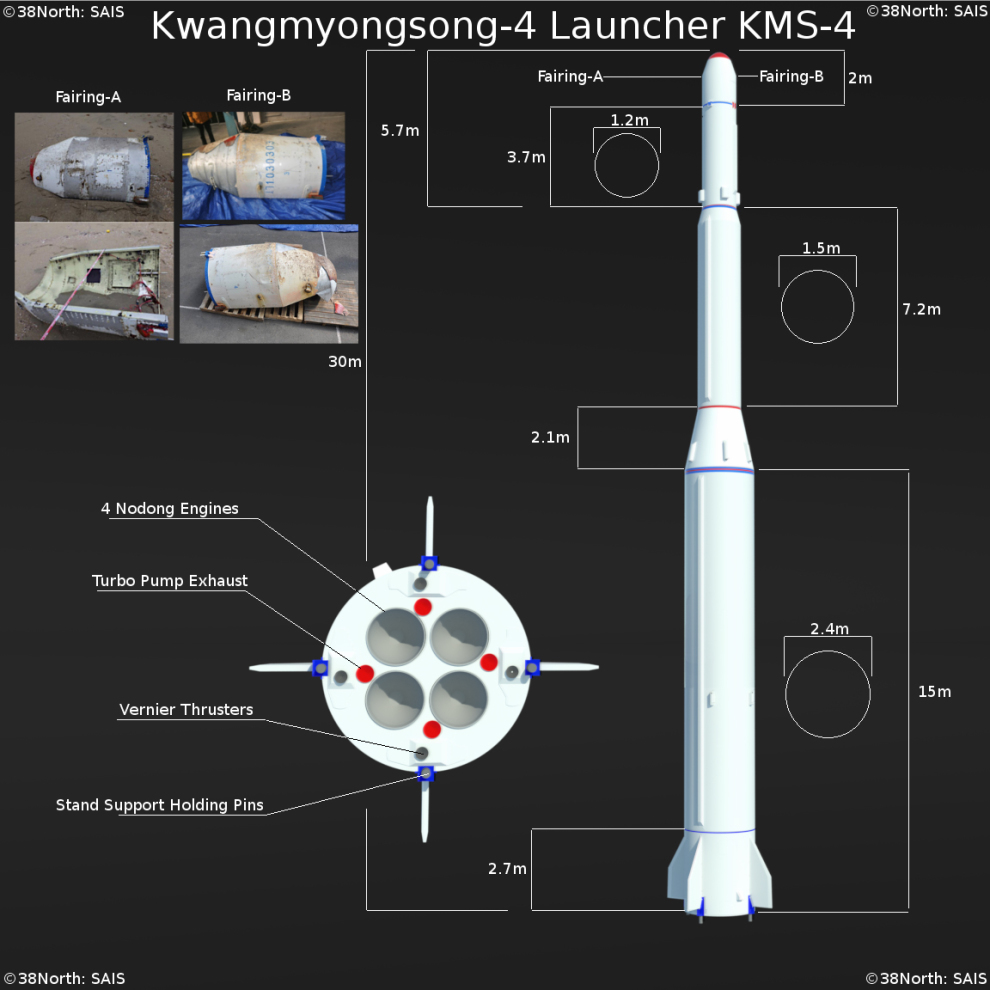
Figure 2 is the KMS-4 prelaunch image of the nose fairing released by KCNA. The attachment points match with those on the debris.
Figure 2. The KMS-4 nose fairing pre-launch.
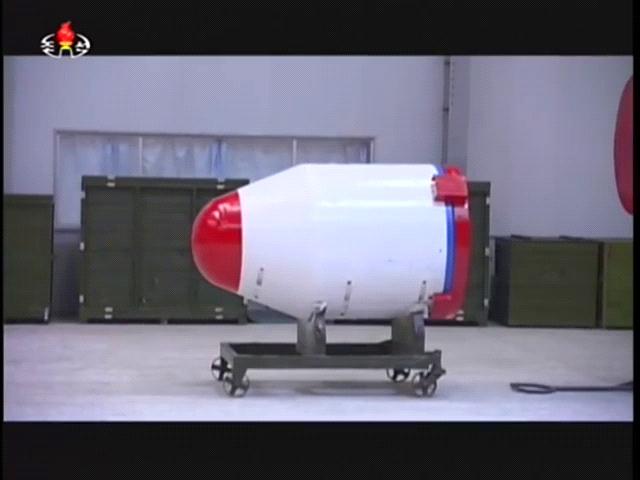
Figure 3. Fairing A washed up on beach in Japan.
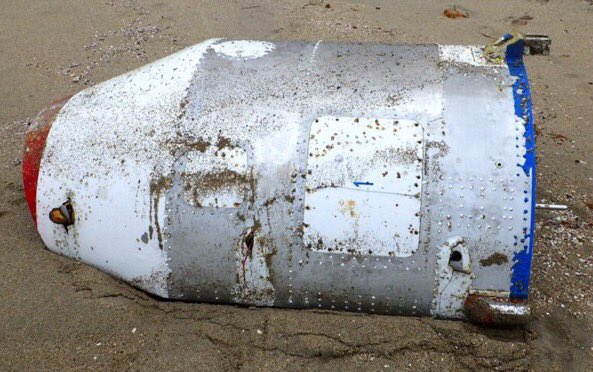
Figure 4 shows the nose fairing recovery locations relative to North Korea’s Sohae Satellite Launching Station and the ground track of the KMS-4 launch. Fairing A apparently drifted a considerable distance from where Fairing B was recovered. This brings to question the buoyancy of the fairing. The material used has not yet been reported, but if it is predominantly metal, it should have sunk instead of being carried by the currents. It is worth noting that while the fairing appears to be metallic, it is common for payload fairings to incorporate thermal or acoustic insulation on the interior. If insulation blankets or coatings were used, they might have been sufficiently buoyant to keep the entire fairing afloat.
Figure 4. Trajectory of the KMS-4.
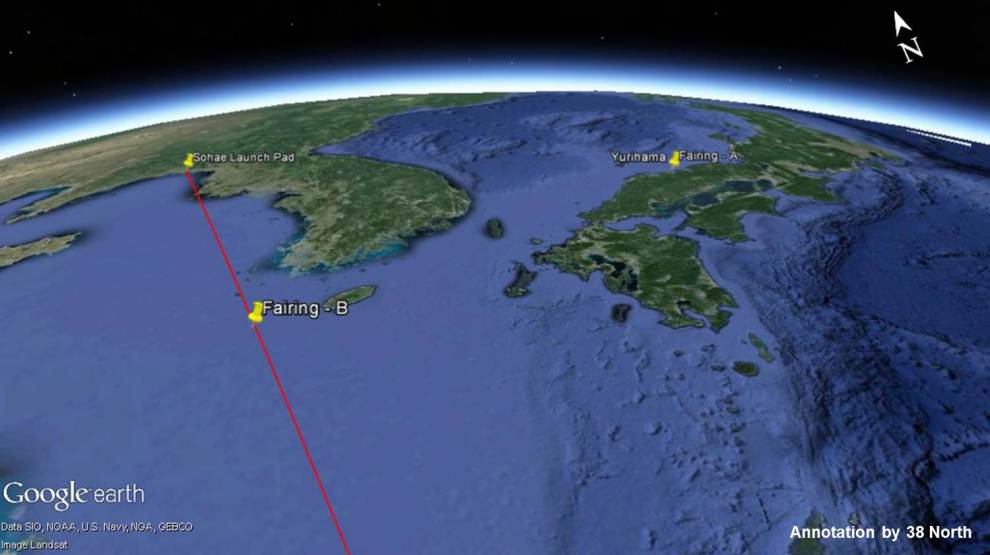
Thursday, June 23, 2016
Evidence of Probable Plutonium Production at the Yongbyon Nuclear Facility
New Evidence of Probable Plutonium Production at the Yongbyon Nuclear Facility
Summary
Recent commercial satellite imagery shows new evidence that North Korea is preparing to commence or has already begun conducting a reprocessing campaign to separate more plutonium for nuclear weapons at the Yongbyon Nuclear Scientific Research Center. This activity consists of the presence of two loaded railroad flatcars at the Radiochemical Laboratory loaded with casks or tanks that may be associated with chemicals used in a preprocessing campaign, a small exhaust plume at the facility’s thermal plant, the replenishing of the coal stockpile for that plant and the likelihood that the 5 MWe reactor is operating at a low level of power or not at all. Also, the North appears to have halted work at Building 500, a facility used to store liquid and solid waste in the past from reprocessing campaigns.
Exactly how much new plutonium Pyongyang can produce if such a campaign is underway remains unclear given uncertainties about the level of operations at the 5 MWe reactor which restarted in 2013. At maximum capacity, the reactor could produce approximately 6 kilograms of plutonium per year, probably enough for two nuclear weapons.
New Activity at Radiochemical Laboratory
Recent commercial satellite imagery shows exhaust plumes present at the Radiochemical Laboratory’s Thermal Plant on May 12 and 22 in addition to plumes observed during February and March of this year. Moreover, coal piles at the thermal plant began to be slowly replenished during February and as of May 22, appear to be at capacity.
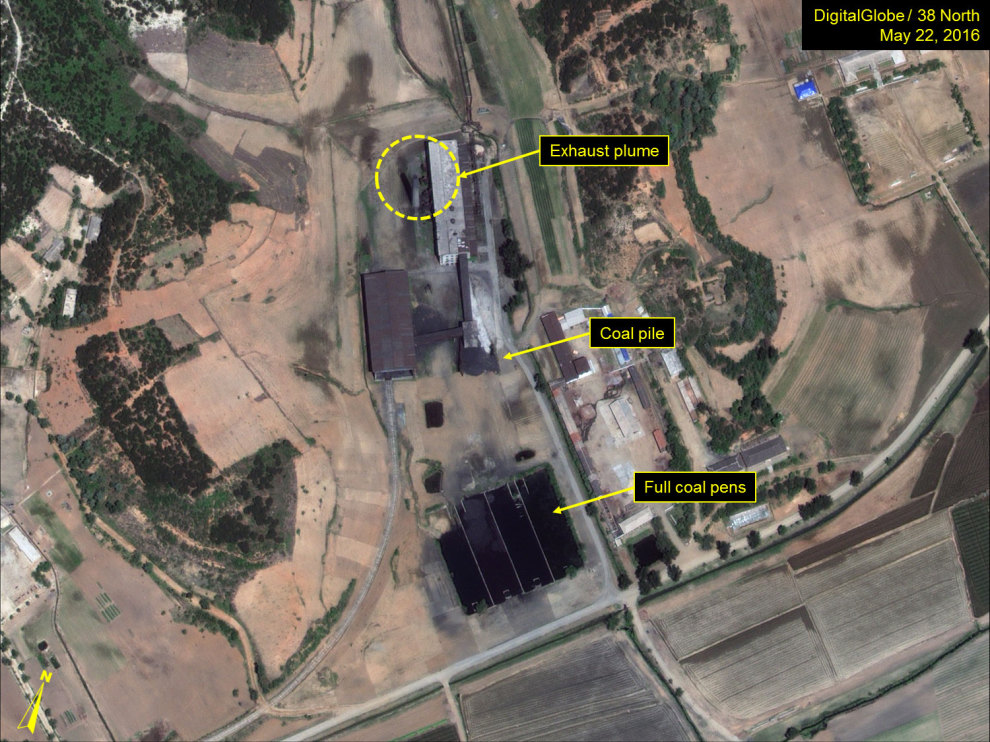
Figure 1. Exhaust plumes seen at Yongbyon’s Radiochemical Laboratory’s Thermal Plant.
Imagery also shows two railroad flatcars present at the facility’s receiving building from May 13 to May 22. Similar flatcars have previously been associated with reprocessing campaigns in the early 2000s, and seen periodically at the facility since earlier this year, are loaded with what appears to be rectangular tanks or casks that could be used to supply chemicals for a reprocessing campaign, haul out waste products or a number of other related activities.
Figure 2. Railroad flatcars seen at the Radiochemical Laboratory’s receiving building.

Operations at the 5 MWe Reactor
Recent imagery shows two large trucks present on the east side of the 5 Mwe reactor, the exact purpose of which remains unclear. Moreover, there are no indications of steam generation or cooling water exhaust. This activity is similar to that noted in most previous 2015 imagery and, when taken in concert with the activity at the Radiochemical Laboratory, suggests that the reactor is not operating or is doing so at an extremely low level.
Figure 3. Two large trucks seen at the 5 MWe reactor.

Previous Activity at Building 500
As noted in previous analysis, the North built a new dirt access road and excavated a trench on the east side of Building 500 (located approximately 180 meters east of the Radiochemical Laboratory) earlier this year. Historically, Building 500 was used to hold liquid waste from reprocessing in large tanks in its lower level and solid waste on its main level but does not appear to have been used since the early 1990s. This trench measures approximately 7.5 meters by 48 meters (whereas the building itself measures approximately 25 meters by 75 meters). Imagery from May 22 indicates that the trench has not significantly changed since mid-April.
Figure 4. No significant change to recently excavated trench at the Building 500.
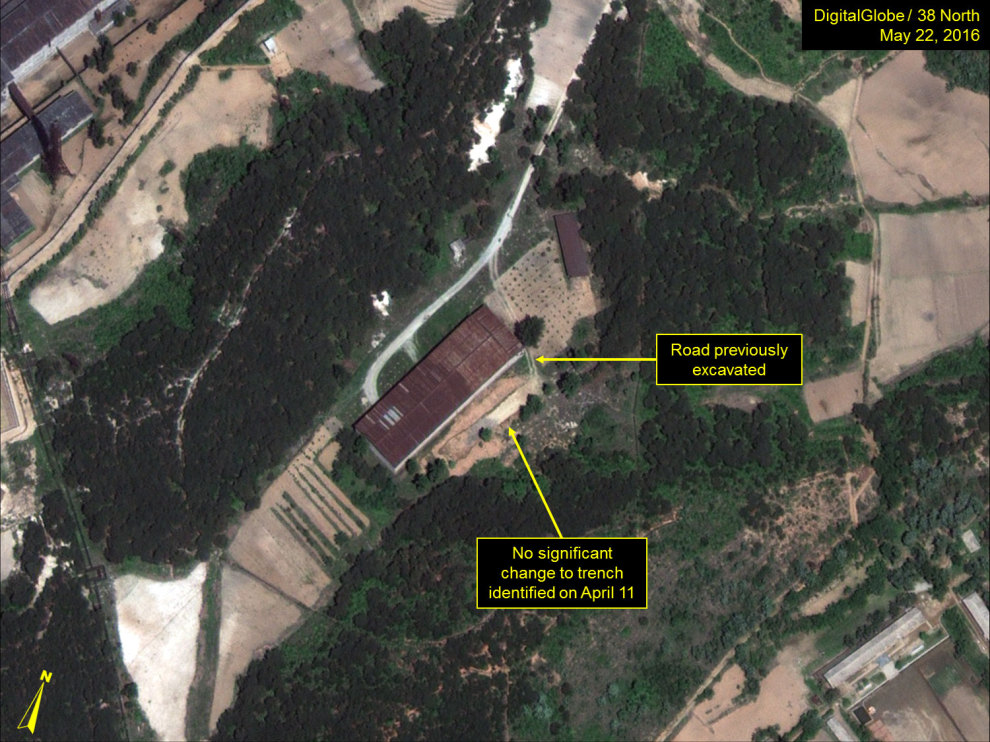
Progress at the Experimental Light Water Reactor (ELWR)
Imagery from May indicates that the North has completed work at the ELWR’s transformer yard. The arrangement of power lines suggests that power could be fed both to the east and west. Grading or excavation operations continue around one of the ELWR’s cooling cisterns located approximately 150 meters southwest of the reactor. It is unclear whether this activity is related to the cooling water systems, the extraction of river sand and gravel, or a combination of both. Regardless, this activity strongly suggests that the ELWR is not yet operational.
Figure 5. Work on the ELWR transformer yard seems complete.
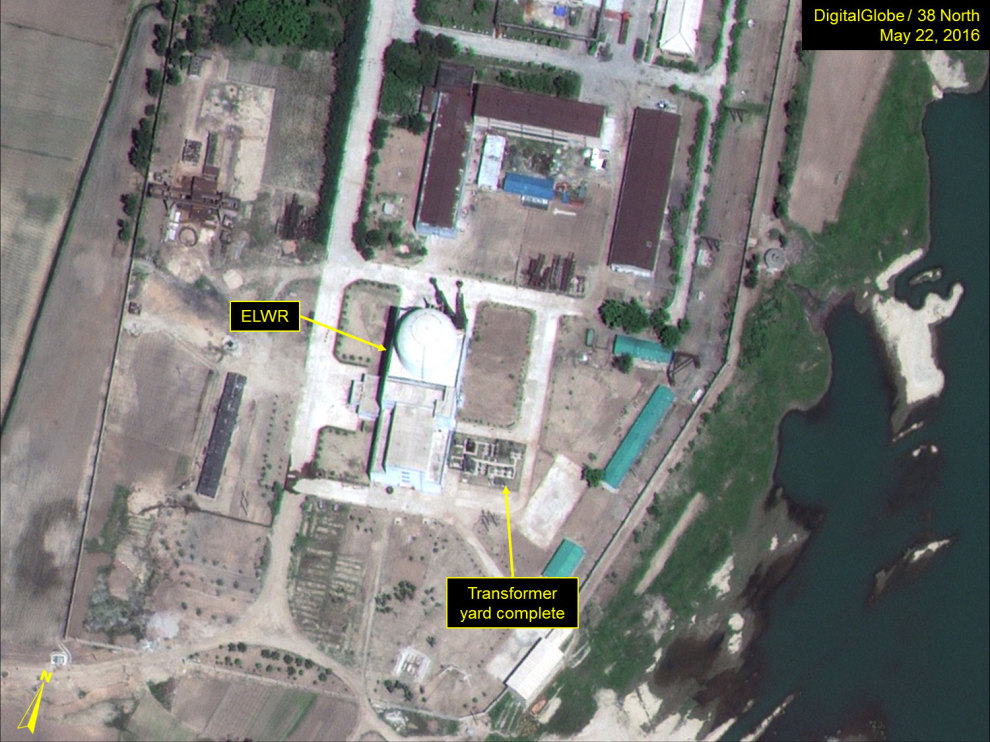
Figure 6. Grading or excavation continues around ELWR cooling cisterns.
Continued Activity at the Uranium Enrichment Complex
Imagery from May 22 shows only minor activity at a new facility whose purpose remains unclear in the southeastern corner of the uranium enrichment complex. While the building itself appears externally complete (with the exception of some surrounding roadwork) some foundation-type work has taken place adjacent to the chimney on the east side of the building. Additionally, the heavy construction crane observed in this area in May 11 and May 13 imagery is no longer present. This crane may have been moved to the area immediately south of the Centrifuge Building as a crane of similar size and configuration is present the May 22 image. No clear explanation for the crane’s presence here is apparent, however, it suggests that construction or maintenance work may soon start at the building south of the Centrifuge Building.
The rail yard that serves the Uranium Enrichment Complex remains active with the presence of several rail cars and material on the ground. Significantly, as noted above, is the presence of a flatcar loaded with four rectangular tanks or casks that is identical to one at the Radiochemical Laboratory.
Figure 7. Heavy construction crane seen next to Centrifuge Building, may indicate construction or maintenance work starting soon.
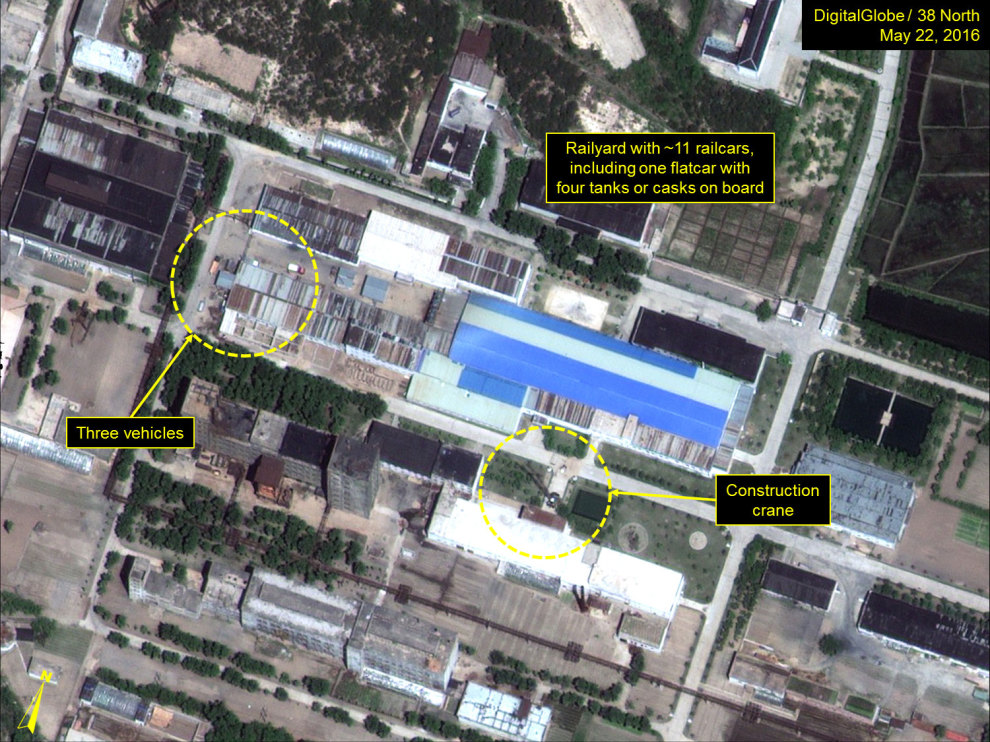
KIM's Partial Success for the Musudan
Summary
North Korea’s latest Musudan (Hwasong-10) missile test finally demonstrated the full performance of the missile’s propulsion system, and at least a minimally functional guidance system. The trajectory was not representative of an operational launch, and so leaves open questions about the performance of the reentry vehicle. Perhaps more importantly, two launches only a few hours apart and with one missile breaking up in flight, gives the North Koreans little chance of understanding what went wrong. The Musudan is not a reliable weapon, and Pyongyang does not seem to be trying to make it a reliable weapon. But even if this is just a propaganda stunt and the Musudan is to be quietly abandoned, this partial success increases the likelihood that North Korea’s KN-08 and KN-14 road-mobile inter-continental ballistic missiles (ICBMs) will reach operational status early in the next decade.
The Persistent Pursuit of the Musudan
After four consecutive failures in rapid succession, we figured we might have seen the last of North Korea’s Musudan missile. Given the pace of testing earlier this year, faster than any technical results could be interpreted and incorporated into a revised design, there was little chance of North Korea obtaining a useful weapon. At best, and only by luck, it might have scored a propaganda victory with a marginally successful flight. And with every failure, the odds of that seemed increasingly remote.
But if the North Koreans are in too much of a hurry to do the job right, they are at least persistent in doing something. And now it appears that they have at least a partial success to show for it. We have confirmed reports that two missiles were fired from mobile launchers near Wonsan on June 21, with one missile disintegrating in flight perhaps 150 km downrange and the second impacting at a range of 400 km. That is little more than a tenth of the Musudan’s expected range of roughly 3,500 km, but it is more than we had ever seen before.
This may be due to a modification in the missile’s aerodynamics. North Korea has released pictures of what appears to be a Musudan in flight with a set of eight grid fins around the base, which weren’t present in previous satellite or parade photos or in the old Soviet R-27 missile on which the Musudan is based. Presumably the North Korean engineers guessed that their modifications to the Musudan had compromised its stability in early flight, and that some extra aerodynamic controls would fix that problem. With no more than two months to work, this cannot have been much more than a jury-rigged fix based on an educated guess, but it was apparently a good one. Now they have to guess what went wrong to cause a missile to break up at 150 km, which will be rather more difficult.
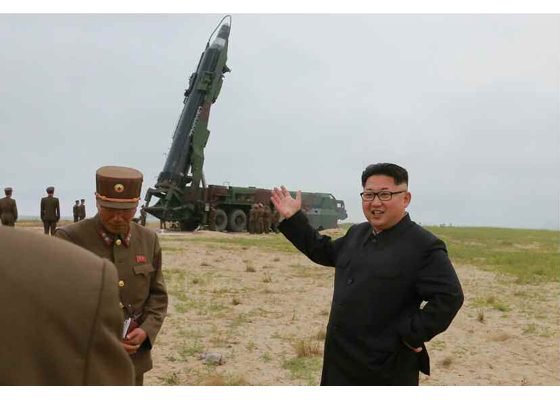
Reports from Japan indicate that the second missile had reached an altitude of over 1,000 km, with North Korea claiming a very precise 1,413.6 km. This is far higher than would be normal for a missile of that size. A bit of analysis indicates that achieving this altitude would require roughly the full performance of the Musudan missile’s propulsion system, devoted to an almost perfectly vertical ascent. That’s not very useful from a military perspective, but it is still an impressive feat for a missile that last month was blowing up on the launch pad.
As a test, this isn’t as useful as launching the missile on its more usual ballistic arc. It gives the engines a full workout, but makes it harder to verify the performance of the guidance system. It also provides a different reentry environment, and testing the reentry vehicle is going to be critical to North Korea. Their older missiles entered the atmosphere at no more than half the Musudan’s speed. The North Koreans probably now know, for the first time, what happens when one of their warheads enters the atmosphere at roughly 10,000 miles per hour, but at an abnormally steep angle which will give a shorter but more intense heating load and do most of its deceleration lower in the atmosphere than it would in an operational launch. They might still not know whether the warhead would survive in an operational flight.
Why would they have tested a missile in such a manner? Examining a map of the region shows that there is really no way to launch a missile from Wonsan to a range of more than 1,000 km without overflying some foreign country, most likely Japan. The Japanese take a dim view of North Korean missiles flying over their country, and they have Aegis-equipped warships capable of shooting down missiles. Pyongyang apparently didn’t want to take that provocative risk.
They could have launched the missile from their Sohae Satellite Launching Station, which has clear range to the south as far as the Philippines. North Korea’s orbital launches have used this site and this trajectory, and it would have made for a more realistic test of the Musudan. Given that the Musudan is a mobile missile, they could have launched from any paved road along the southeast coast for the same effect. But North Korea’s engineers almost certainly would have wanted the support of powerful tracking radars and other infrastructure associated with a permanent launch site, and the Sohae site has only been used for North Korea’s nominally civilian satellite launches. There may have been some internal politics involved in the decision to loft the missile high over the East Sea and bring it down at such a short range.
The bigger limitation of this test is the decision to launch two missiles only a few hours apart. That decision greatly limits what can actually be learned from the test. There is no possibility, in that timeframe, of figuring out what went wrong with the first missile and fixing it. As with the earlier Musudan tests, this isn’t so much an engineering program so much as an exercise in tossing a coin or rolling a die until it comes up with the result they like. If North Korea’s sixth and latest Musudan launch counts as a success in their minds—and it well might—the one before it was still clearly a failure. Do they now have a reliable missile that had a spot of bad luck, or a dud that got lucky and worked once? We don’t know. Neither do they. And they knew from the start that they wouldn’t know if they had a reliable missile in the end.
So we should probably assume they don’t really care, that this was about propaganda and image rather than engineering and weapons development. They have achieved something that is as close to a win as possible without overflying Japan, and if they try again there’s a good chance that Musudan #7 will be an embarrassing failure just like Musudan #5.
Best case, they declare victory and go home, and make a quiet note to never actually trust the Musudan in wartime. Worst case, they tell their engineers to go back to their ground test facilities and turn this one-shot stunt into a useful weapon. The engineers in question would probably be quite happy to know they still have jobs, and turning the results from this spurt of unreasonably fast testing into a reliable weapon, would occupy them for a year or two at least. If they come back a year from now, testing Musudan missiles one at a time and with three to six months between tests, then we can start worrying about an operational Musudan.
But we should also consider worrying about an operational KN-08 or KN-14. These missiles use the same ex-Soviet engine as the Musudan, but in a clustered and multi-stage configuration capable of reaching much of the US mainland. We have seen them test this engine on the ground, but until now they had never successfully flown one. Even if North Korea retires the Musudan as too unreliable for anything but propaganda stunts, they will presumably ship any test data to the engineers building the ICBMs. And those engineers don’t seem to be under any pressure to rush into premature flight testing.
Regardless of the ultimate fate of the Musudan, the credibility of the KN-08 and KN-14 road-mobile ICBMs has increased a few notches. The North Koreans have the engines they need, and they can at least sometimes make them work in flight. There is still a great deal of work for them to do. The clustered twin-engine installation in particular will likely give them a few surprises on its first flight, and it will likely take them several tries to get the complete system right. We still don’t expect them to have those missiles operational before 2020, but early flight testing by that date is increasingly likely.
Subscribe to:
Posts (Atom)


